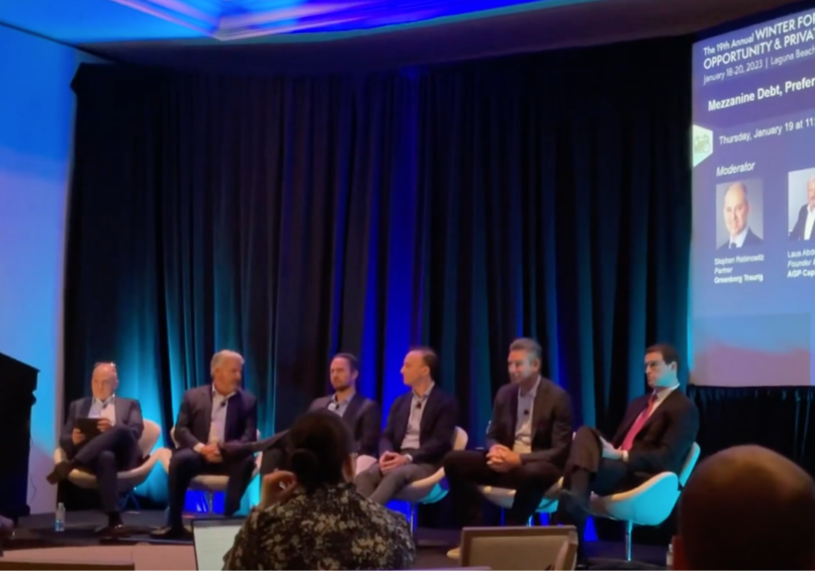Sponsors pursuing value-add strategies have been forced to accept the reality that unless they intend to bring 35% equity to the table (or more) for a new acquisition, a senior loan won’t be sufficient to make up the rest of the capital stack. Similarly, proceeds available to refinance pending maturities may often fall short of the existing debt, requiring a fresh infusion of capital.
Because of this dynamic, mezzanine debt, preferred equity and other higher leverage providers have quickly become go-to sources of gap financing, with several funds announcing dedicated vehicles designed to salvage deals teetering on the brink of collapse.
At the IMN Winter Forum on Real Estate Opportunity & Private Fund Investing Conference, bridge and new construction lenders addressed how they are differentiating themselves from the crowd and positioning themselves opportunistically to address sponsor needs.
S3 Capital’s Joshua Crane explained that the retrenchment of banks from the CRE lending created new opportunities for nimble construction and bridge lenders to differentiate themselves.
“Everything we are doing is ground-up residential. The reason some people are still going for loans now as interest rates rise is that they have spent a long time assembling these parcels and whatever county they are in requires them to activate their parcels. We are seeing good loans before from sponsors we previously did not see before because the banks have stepped back. “
Malcom Davies, founder of mortgage broker Way Capital, made the counter-intuitive observation that under challenging market circumstances, engaging a small number of highly targeted lenders can be essential in building sufficient trust to get more advantageous terms.
“We just closed a loan where we went to one lender. We promised to that lender it would not be overly shopped. Right now, you can’t overly shop a deal so that it’s a chase. No one has time for that. It’s a hard market. And everyone is working hard to get those particular deals done with the relationships that matter.”
Even with the increase in mezzanine debt and preferred equity vehicles, panelists emphasized how important a reinvigoration of the securitization market could be expanding bridge lending capacity overall.
“Some AAA bond buyers,” observed Daniel Katz of BrightSpire Capital, “JP Morgan being one of them, came out of the bond market late last summer early fall and that also blew pricing out. I heard they are back in due to the relative value of CRE CLOs vs corporate CLOs is starting to look attractive again. I do think you will see that market start to pick up again this year. People need enough inventory to do it. That will help to de-fog the capital markets a bit. The money center banks need to clear their lines. Then the wheels can start spinning again. “
Similarly, Mr. Abro argued that as increased clarity around how assets will perform in the current macro environment as well as near-term Fed policy would be a net benefit to the max leverage available to sponsors.
“We have curtailed our advance rates from 75% to 65% because that’s just where it sizes at the higher cost of capital. But once you get through this a little bit, we could probably see our way clear to 70% or so, which would solve half the problem and then sponsors would find that gap financing, preferred equity or make a contribution or capital call to get the cap stack sorted out. “
Like the Senior Lender Roundup panel held the same afternoon, lenders were not quick to resign themselves to low production in 2023.
“I think that optimistically you are looking at 2023 as a mirror image of 2022 where 2022 was front loaded and 2023 will be back ended. Dust needs to settle on where the Fed goes. Once they hit what they say is a terminal rate that will allow everyone to reset their models,“ Katz asserted.
The lenders did caution borrowers against wasting their time by seeking unrealistic terms.
“When you present a loan request, you have to be market oriented. We are looking at the same data as you are looking at. Put assumptions that make sense for the current environment,” said Mr. Abdo.
Mr. Davies also emphasized the reverberations being felt for sponsors seeking equity capital.
“It’s been very challenging over the last 90 days to place equity capital at the last dollar of exposure, and I think that has been where the stumbling block has been for many transactions.
There is massive growth in this Co-GP marketplace, where we inject a strong GP sponsor into a deal with a weaker sponsor. If you are a younger sponsor and trying to deals in this market, teaming up with someone who has a much larger balance sheet and more experience is certainly a very strong value-add.”
_______________________________________________________________________________________________
Click Here to read more takeaways from the IMN Winter Forum on Real Estate Opportunity & Private Fund Investing Conference.
Written by Vernon Beckford at [email protected]



